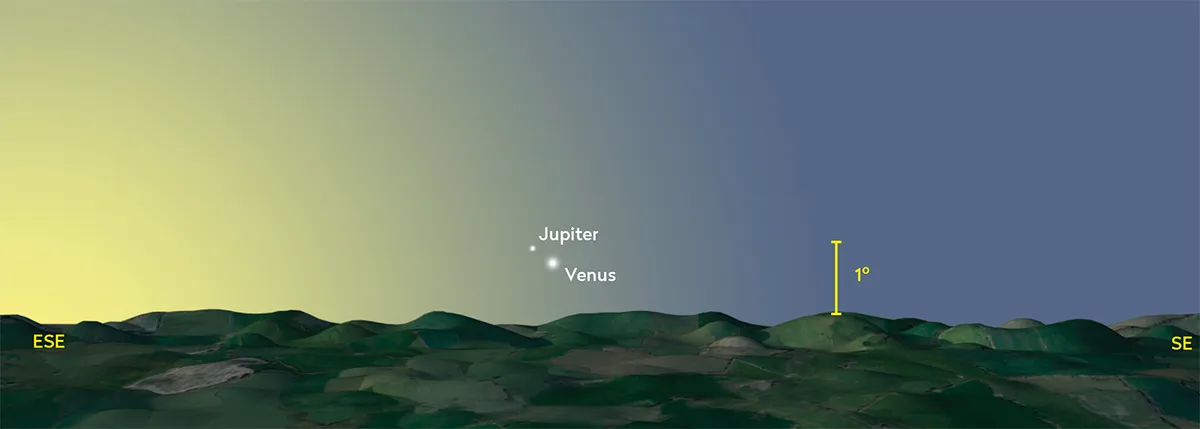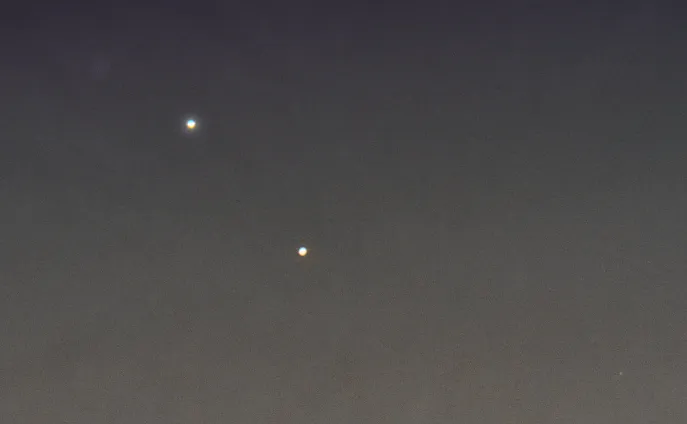
Jupiter and Saturn are slowly emerging into the morning sky, having reached conjunction with the Sun on 23 and 29 January respectively. Dazzling Venus has been visible in the morning sky since June 2020. In February there will be two close and somewhat challenging conjunctions between Venus, Jupiter and Saturn.
It’s Saturn’s turn first, Venus and Saturn appearing just 23 arcminutes apart on the morning of 6 February. Jupiter’s close encounter follows on 11 February, when both planets are 31.5 arcminutes apart.
- For more observing advice, read our guide on how to see the planets in February 2021.
The challenging element occurs because all three planets are awkwardly positioned from the UK, rising less than 30 minutes before sunrise.
While mag. –3.8 Venus stands out against a bright twilight sky, it’s unlikely that mag. 0.9 Saturn will be able to do the same.
It’s even questionable whether mag. –1.8 Jupiter will be that easy as a low altitude object in a bright February morning sky.
If you want to give it a try with the naked eye or using binoculars, the conjunctions rise above the southeast horizon approximately 20 minutes before sunrise.
A word of warning: extreme care needs to be taken to ensure you don’t inadvertently look at the Sun. Whatever you do, it’s imperative to stop looking if the Sun has appeared above the horizon.
For more events like this, keep an eye on our regularly-updated guide to upcoming astronomy conjunctions. Or if you'd like to try and image this month's events, read our guide on how to photograph a conjunction.
How to see the conjunctions

At this point you might be forgiven for thinking we’ve introduced you to two conjunctions you can’t see!While this may be the case for the naked eye, if you have the ability to locate Venus during the day, this changes the game.
It is possible to see Saturn under daylight conditions, but it’s tricky at best. Being dim, it appears with extremely low contrast.
As a consequence, and considering it’s a low object from the UK anyway at the moment, a clear, crisp February sky is needed to stand a chance.
Jupiter is a better prospect, but even at mag. –1.8 it too can appear faint under blue-sky conditions. The location of Venus near to both gas giants is a huge bonus because Venus is relatively easy to see in daylight.

There are various techniques that can be used to spot it with a telescope during the day. Using filters with your telescope for solar viewing, centring on the Sun’s disc and using setting circles to offset to Venus is one method.
Alternatively, some Go-To systems will allow you to slew to Venus using the filtered Sun as a navigational starting point.
If this is not possible, a Go-To mount set up during the previous night and left on may be the way to go. If you don’t have Go-To, but can locate Venus soon after rising, it should then be possible to stay with the planet until it has gained additional altitude.
Pete Lawrence is an experienced astronomer and a co-host of The Sky at Night. This guide originally appeared in the February 2021 issue of BBC Sky at Night Magazine.
